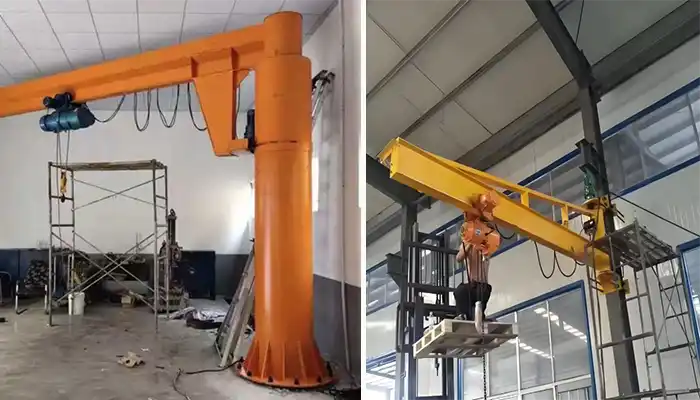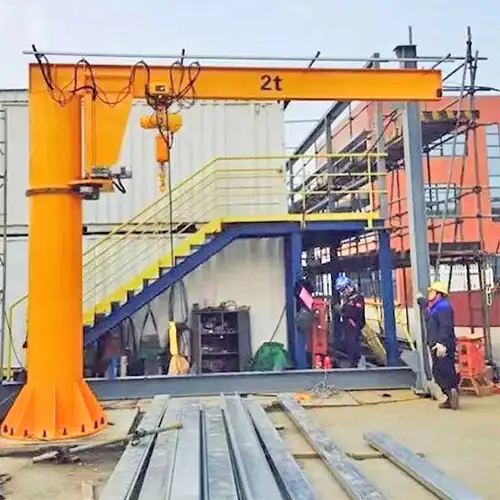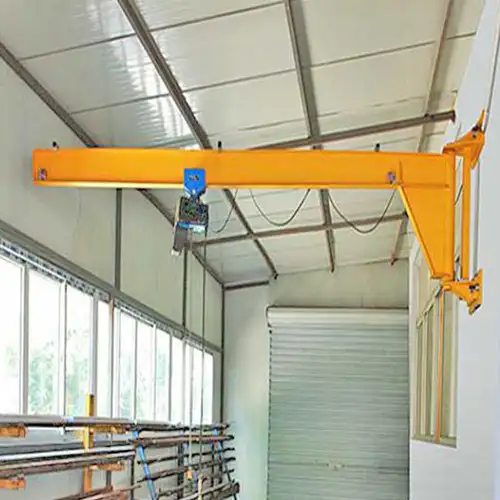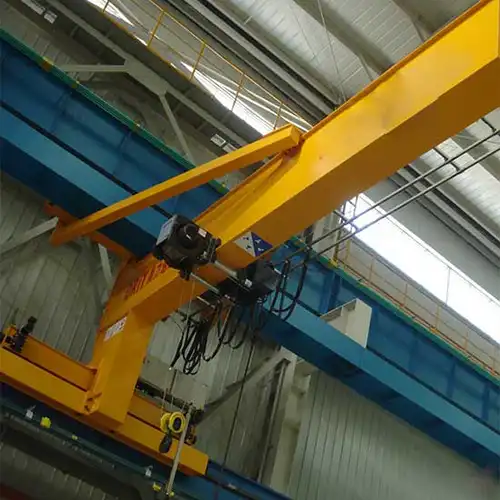
Why 3 Ton Jib Cranes Are Ideal for Fire Extinguisher Workshops
Manufacturing fire extinguishers involves several steps: assembling the cylinder, installing valves, filling with extinguishing agent, testing, and packaging. Each stage requires moving parts that can be heavy, awkward, or bulky. For example, a single filled cylinder may weigh 25–30 kg, and batches ready for assembly or storage can quickly add up. Handling these manually slows production and risks worker injuries.
Why handling efficiency matters:
- Saves time on repetitive lifting and moving.
- Reduces fatigue for workers throughout long production shifts.
- Keeps the workspace organized and minimizes accidents.
This is where a 3-ton jib crane proves extremely useful. These cranes are compact, sturdy, and precise, designed for lifting medium-weight loads at workstations. They make moving cylinders, assemblies, or even full batches simple and safe, letting workers focus on assembly and quality rather than struggle with heavy lifting.
Practical benefits for a fire extinguisher production line:
- Safety: Limits manual lifting and reduces strain on employees.
- Efficiency: Speeds up movement between workstations for smooth workflow.
- Space optimization: Wall-mounted or column-mounted options free up floor space.
- Adaptability: Can support various lifting attachments like hooks or trolleys depending on production needs.
In short, a 3-ton jib crane is not just a lifting tool—it's a practical solution for keeping production moving safely, efficiently, and in an organized way.
3 Ton Jib Cranes Types for Your Selection
A jib crane is a type of lifting device designed to move medium-weight loads within a limited radius. Unlike overhead cranes that span an entire workshop, jib cranes focus on specific workstations, making them ideal for tasks that require precision and frequent lifting.
Common variants for fire extinguisher production lines:
- Wall-mounted jib cranes: Fixed to a strong wall, ideal for corners or along assembly lines. Saves floor space and keeps the crane out of the way.
- Freestanding (floor-mounted) jib cranes: Stand independently and can be positioned anywhere in the workshop. Offers more flexibility for changing layouts or multiple lifting points.
Why 3 Ton Capacity is Ideal
When selecting a crane for fire extinguisher production, capacity is critical. A 3-ton jib crane hits a practical sweet spot.
Practical considerations:
- Component weight: Fire extinguisher parts, including cylinders, valves, and assembled units, usually range from 20 kg for empty components to several hundred kilograms per batch. A 3-ton crane can easily handle multiple items at once.
- Flexibility: It allows lifting heavier parts or batches without overloading the hoist, providing room for future production increases.
- Safety margin: Repetitive lifting tasks can strain the crane. Choosing a 3-ton capacity ensures operations stay within safe limits, reducing wear on equipment and minimizing risk of accidents.
In short, a 3-ton jib crane balances strength, precision, and safety, making it ideal for handling the variety of loads in fire extinguisher production lines.
Benefits of Swing Jib Crane for Fire Extinguisher Production Lines
Swing jib cranes are compact, reliable, and designed for precise lifting. They can make a noticeable difference in day-to-day operations, improving efficiency, safety, and overall workflow in a fire extinguisher production line.
Efficiency and Workflow Optimization
A swing jib crane helps components move smoothly between stations, reducing delays and unnecessary handling.
- Faster operations: Components like cylinders and valves can be loaded and unloaded quickly, speeding up assembly, filling, and testing stages.
- Reduced downtime: Smooth material movement keeps the production line continuous, avoiding interruptions.
- Worker focus on core tasks: Employees can concentrate on assembly and quality control instead of struggling with heavy lifting.
Space Optimization
Workshops often have limited floor space, and a cluttered layout slows down work. Swing jib cranes provide efficient lifting without taking up much room.
- Maximized workspace: The compact design fits into corners or along walls, freeing up space for other equipment or storage.
- Improved workflow: Clear floor space reduces the chance of collisions or bottlenecks between workers and machines.
Enhanced Safety
Manual lifting of fire extinguisher parts can lead to fatigue or injuries. A swing jib crane ensures safer operations and precise positioning.
- Reduced injury risk: Employees avoid heavy or awkward lifts, protecting their health.
- Accurate placement: Components can be positioned precisely for assembly or storage, reducing accidents and product damage.
- Consistent safe operations: The crane enables repeatable, controlled movements that comply with safety standards.
Versatility
Swing jib cranes can handle a variety of lifting tasks and attachments, adapting to changes in production needs.
- Flexible lifting: Works with hooks, trolleys, vacuum lifters, or other attachments for different component types.
- Seamless integration: Can be used alongside conveyors, workstations, or storage areas without disrupting workflow.
- Multiple applications: Handles different lifting tasks without the need for extra equipment, saving costs and space.
Swing jib cranes offer tangible benefits in daily operations: faster workflow, safer lifting, better space use, and adaptable performance. They are a practical investment for any fire extinguisher production line.
Installation Considerations
Installing a jib crane correctly is just as important as choosing the right capacity. Proper installation ensures smooth operation, safety, and long-term reliability.
Floor-Mounted vs. Wall-Mounted Options
Choosing the mounting type depends on your workshop layout and available space.
- Floor-mounted cranes: Can be positioned anywhere in the workshop, providing flexible lifting points for assembly or storage areas. Ideal for open floor plans or changing layouts.
- Wall-mounted cranes: Save floor space by being fixed along walls, leaving more room for other equipment or aisles. Perfect for compact production lines or corner workstations.
Power Supply and Electrical Requirements
The crane's power needs must match the workshop's electrical setup to avoid disruptions.
- Reliable operation: Proper voltage and current ensure the crane works smoothly without downtime or motor strain.
- Reduced maintenance issues: Correct electrical setup prevents overheating and extends the life of the hoist.
- Energy efficiency: Matching power supply with crane requirements helps avoid unnecessary energy costs.
Load Testing and Compliance with Safety Standards
Before operation, cranes must be tested and certified to meet local and international safety regulations.
- Worker safety: Verified load capacity prevents overloading, reducing accident risk.
- Regulatory compliance: Meeting ISO, CE, or local standards avoids fines or production stoppages.
- Peace of mind: Ensures that the crane is safe for daily repetitive use in a busy production environment.
Proper installation isn't just a technical step—it directly affects safety, efficiency, and long-term performance of your jib crane. Choosing the right mounting, power setup, and compliance checks makes operations smoother and reduces future headaches.
Maintenance and Longevity
A jib crane is a long-term investment, and regular maintenance ensures it continues to operate safely and efficiently. Simple upkeep can prevent costly downtime and extend the life of your equipment.
Routine Inspection
Regular checks on hoists, bearings, and structural components are essential.
- Early problem detection: Spotting wear or damage early prevents unexpected breakdowns.
- Worker safety: Ensures all moving parts are in proper condition, reducing accident risk.
- Consistent performance: Maintains smooth operation and reliable lifting capacity throughout production cycles.
Lubrication, Alignment, and Safety Checks
Keeping the crane properly lubricated and aligned keeps everything running smoothly.
- Reduced wear and tear: Lubricated bearings and joints last longer and require fewer repairs.
- Accurate lifting: Proper alignment prevents uneven loads and ensures safe, precise handling.
- Safer operation: Routine safety checks confirm that brakes, limit switches, and hoists function correctly.
Low-Maintenance Advantage
Some jib cranes are designed for minimal maintenance, which is ideal for busy production lines.
- Less downtime: Reduces interruptions for repairs, keeping the workflow steady.
- Lower operating costs: Minimal maintenance means fewer parts replacements and less labor.
- Reliable productivity: High-output workshops can depend on cranes to operate day after day without performance drops.
Case Studies / Practical Examples
Seeing jib cranes in action shows why they are so valuable on fire extinguisher production lines. These real-world examples highlight their practical benefits.
Example 1: Assembly Line Handling Cylinder Bodies
On a mid-sized fire extinguisher workshop, a 3-ton swing jib crane was installed along the assembly line. Workers used the crane to lift and position cylinder bodies for valve installation and assembly.
Practical benefits observed:
- Faster assembly: Workers no longer spent time manually moving heavy cylinders.
- Reduced strain: Employees experienced less fatigue, allowing them to maintain focus and accuracy.
- Consistent workflow: Cylinders were positioned precisely, keeping the line running smoothly without interruptions.
Example 2: Filling Station Operations with Repeated Lifting Cycles
In another workshop, the crane was used to lift filled cylinders from the filling station to the storage area. This task previously required multiple manual lifts.
Practical benefits observed:
- Improved speed: The crane handled multiple units quickly, reducing bottlenecks.
- Enhanced safety: Fewer manual lifts meant lower risk of injury.
- Better space utilization: The crane moved cylinders efficiently without cluttering the floor, keeping the workspace organized.
Measurable Improvements
Across these examples, the workshops saw clear improvements:
- Production speed: Lifting and moving parts became faster and more reliable.
- Worker safety: Fewer manual lifts reduced injuries and fatigue.
- Space efficiency: Optimal crane placement kept aisles clear and equipment accessible.
These case studies demonstrate that a 3-ton jib crane is not just convenient—it's a practical tool that directly improves efficiency, safety, and organization in fire extinguisher production lines.
Buying Checklist for Fire Extinguisher Manufacturers
Choosing the right jib crane for your fire extinguisher production line requires careful consideration. A well-selected crane improves efficiency, safety, and overall workflow.
Determine Maximum Load and Lifting Height Requirements
Understand the weight of individual components and full assemblies, as well as the height they need to be lifted.
Practical benefits:
- Safe operation: Ensures the crane can handle all loads without risk of overloading.
- Future-proofing: Allows for handling larger batches or heavier parts as production grows.
- Accurate positioning: Correct lifting height enables precise placement at assembly, filling, or storage stations.
Select Appropriate Mounting Type
Decide between wall-mounted, floor-mounted, or column-mounted cranes based on workshop layout and space availability.
Practical benefits:
- Space efficiency: Wall-mounted cranes free up floor space for other equipment or aisles.
- Flexibility: Floor-mounted cranes can be moved or repositioned if workflow changes.
- Optimized workflow: Correct mounting ensures smooth material flow across workstations.
Verify Safety Features and Compliance Certifications
Check for limit switches, emergency stops, overload protection, and adherence to ISO, CE, or local regulations.
Practical benefits:
- Worker protection: Safety features reduce the risk of accidents during daily operations.
- Regulatory compliance: Avoid fines and production stoppages by meeting required standards.
- Reliable performance: Certified cranes are tested to operate consistently and safely under repeated use.
Evaluate Supplier Support and Customization Options
Consider suppliers that offer technical support, training, and the ability to customize cranes for your specific needs.
Practical benefits:
- Tailored solutions: Customizations ensure the crane fits your exact workflow and lifting requirements.
- Reduced downtime: Reliable supplier support helps quickly resolve issues or perform maintenance.
- Long-term value: Strong partnerships provide access to spare parts and upgrades over the crane's lifespan.
Using a 3-ton jib crane on a fire extinguisher production line brings clear, practical advantages:
- Efficiency: Speeds up the movement of cylinders, valves, and assemblies between workstations.
- Safety: Reduces manual lifting, lowering the risk of injury and fatigue for workers.
- Space optimization: Compact design keeps floors clear and workflow unobstructed.
These cranes are especially suitable for fire extinguisher workshops, where repetitive handling of medium-weight loads is common. They help maintain a smooth production line while ensuring components are accurately placed for assembly, filling, or storage.
Key takeaway: Consulting with a trusted supplier allows you to select a crane that fits your specific layout, load requirements, and workflow. A well-chosen jib crane improves daily operations, minimizes risk, and keeps your production line running efficiently.
Send Us an Inquiry on 3 Ton Jib Cranes
If you're looking to improve efficiency, safety, and workflow in your fire extinguisher production line, a 3-ton jib crane could be the perfect solution.
We invite manufacturers to request a personalized quote or schedule a workshop assessment. Our team will evaluate your layout, lifting requirements, and production needs to recommend the most suitable crane setup.
Why reach out to us:
- Customized solutions: Cranes can be tailored with specific mounting types, lifting attachments, and working radii to fit your workshop perfectly.
- Expert guidance: Get practical advice on installation, operation, and maintenance to maximize performance.
- Flexible options: From wall-mounted to floor-mounted setups, we can adapt to your unique production requirements.
Don't wait—contact us today and discover how a 3-ton jib crane can streamline your operations, protect your workers, and make your fire extinguisher production line safer and more efficient.


